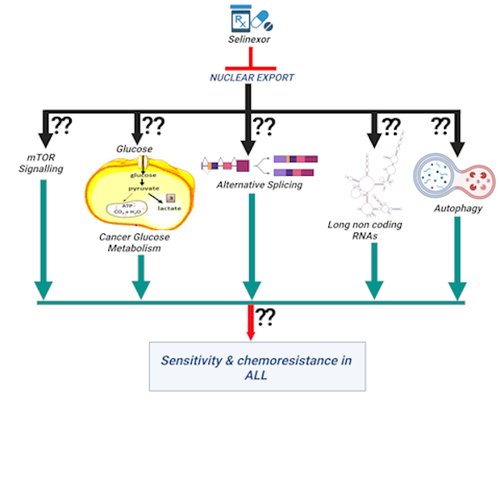-
Home
-
About JCTR
-
Gold Open Access
-
Issues
-
Editorial board
-
Author guidelines
-
Publication fees
-
Online first
-
Special issues
-
News
-
Publication ethics
-
Partners
-
Submit your manuscript
-
Submit your review report
-
Editorial Office
-

This work is licensed under a Creative Commons Attribution-NonCommercial 4.0 International License. ISSN print: 2382-6533 ISSN online: 2424-810X
Volume 9 Issue 6
A possible novel therapeutic targets of Selinexor in acute lymphoblastic leukemia: a comprehensive review
Pushkar Malakar*, Nitin Sagar, Bandana Chakravarti, Didhiti Singha, Meghna Mondal, Rajesh Kumar Kar
Malakar et al. J Clin Transl Res 2023; 9(6):23-00088
Published online: November 22, 2023
Abstract
Background and aim: Acute Lymphoblastic Leukemia (ALL) presents a formidable challenge in pediatric and adolescent healthcare due to its aggressive nature and high relapse rates. Despite therapeutic advancements, the demand for more effective treatments remains pressing. In the realm of hematologic malignancies, Selective Inhibitors of Nuclear Export (SINE) have emerged as promising agents, particularly in evading resistance observed with conventional chemotherapy in Acute Myeloid Leukemia (AML). Selinexor, a prominent SINE compound, has exhibited promising anti-leukemic effects in murine models of AML, laying the foundation for its clinical evaluation. Furthermore, Selinexor has been utilized in clinical trials both as a single-agent therapy and in combination with established regimens for a wide range of solid and liquid tumors. However, the precise impact of Selinexor in the context of ALL, specifically as a single agent or in combination therapies, remains unexplored. Unraveling the mechanistic intricacies underlying Selinexor's actions in ALL holds the key to optimizing its efficacy either as a monotherapy or in combination therapies. Notably, within the intricate landscape of ALL pathogenesis, critical factors including the mTOR signaling cascade, aberrations in cancer glucose metabolism, occurrences of alternative splicing, perturbed expressions of dysregulated long noncoding RNAs, and impaired autophagic processes have emerged as pivotal determinants. This comprehensive review undertakes a systematic exploration of potential therapeutic targets that hold the promise of augmenting Selinexor's efficacy within the unique landscape of ALL.
Relevance for patients: This study highlights the possible therapeutic targets of Selinexor in ALL. Understanding the intricate molecular mechanisms, the rational refinement of Selinexor's administration, both as a single agent and as a synergistic component in combination therapies could lead to new avenues for improving the treatment outcomes in ALL patients.

DOI: http://dx.doi.org/10.18053/jctres.09.202306.23-00088
Author affilation
1. Department of Biomedical Science and Technology, School of Biological Sciences, Ramakrishna Mission Vivekananda Educational and Research Institute (RKMVERI), Kolkata, India
2. Stem Cell Research Centre, Department of Hematology, Sanjay Gandhi Postgraduate Institute of Medical Sciences, Lucknow 226014, India
3. Department of Endocrinology, Sanjay Gandhi Postgraduate Institute of Medical Sciences, Lucknow, 226014, India
4. Department of Neurosurgery, School of Medicine, Yale University, New Haven, Connecticut, United States of America
*Corresponding author
Pushkar Malakar
Department of Biomedical Science and Technology, School of Biological Sciences, Ramakrishna Mission Vivekananda Educational and Research Institute (RKMVERI), Kolkata, India.
Email: pushkarbt@gm.rkmvu.ac.in
Handling editor:
Michal Heger
Department of Pharmaceutics, Utrecht University, the Netherlands
Department of Chemistry, Utrecht University, Utrecht, the Netherlands
Department of Pathology, Erasmus Medical Center, the Netherlands
Department of Pharmaceutics, Jiaxing University Medical College, Zhejiang, China

